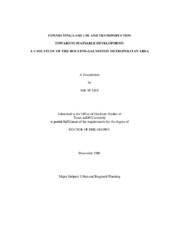| dc.description.abstract | How do land use characteristics affect individual and household travel behavior
in a regional context? Can the investigation justify the land use policies to reduce
automobile dependence and achieve the goals of sustainable development in the
metropolitan areas? Previous research enhanced our understanding of the connections
between land use and travel behavior. It also provided implications for managing
automobile-dependent travel behavior. However, there are questions still left
unanswered about the causal connections between them, and the effectiveness of the
land use policies to manage travel demand.
To address the issues, attention is focused on the effects of land use measures on
travel behavior outcomes from different modeling perspectives. The travel demand
modeling explores the associations between land use and travel behavior. In addition, the
causal modeling helps clarify the causal connections between them. It includes the
structural equation models (SEMs) and the directed acyclic graphs (DAGs). The study focuses on six counties of the Houston-Galveston Area Council (HGAC) area. Travel
behavior outcomes contain individual mode choice, household automobile trip
generation and household total vehicle miles traveled (VMT). Three dimensions (i.e.,
density, diversity and design) of six land use measures are considered, which are
computed using quarter-mile buffers for both trip origins and destinations. Different
travel outcomes and modeling strategies are examined for different travel purposes.
The significance of land use measures in affecting travel behavior is found to be
evident, while varying to a certain degree according to trip purposes, travel outcomes
and methodologies. For individual model choice, multinomial logit (MNL) models, the
SEMs and the DAGs for different trip purposes support the hypothesis that land use
measures directly affect individual mode choice behavior when other factors are kept
constant. There is also evidence from causal models that land use factors indirectly
influence it through travel time. For household automobile trip generation, there is no
evidence to assert that land use measures at origin significantly affect household
automobile trip rates when travel cost and socioeconomic variables are controlled.
However, it is confirmed that land use measures have indirect causal connections with
automobile trips through travel costs for all trip purposes. For household total VMT, it is
found that land use patterns around residential locations are not only significantly
associated, but also causally connected with household VMT. To summarize, compact
development with high density and improved network design generally contribute to the
reduction in automobile dependent travel patterns in the HGAC region. | en |


